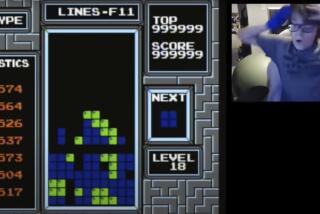Computer Games Makers Have Not Myst a Trick
- Share via
ATLANTA — Two years ago, visitors to the giant Electronic Entertainment Expo could hardly escape the constant boasts that this game or that game was destined to be “the next Myst,” the subdued, surrealistic adventure that became the first true mega-hit of computer gaming.
This year, though, no one made that claim. Not even the folks actually producing the next Myst, a sequel called Riven. In fact, they take minor offense at the label, preferring to call their endeavor “the first Riven.”
Whatever. Due on shelves this fall, Riven stood out as one of the few true gems at the annual computer- and video-game trade show. Sequels and knockoffs of successful games dominated the show’s painfully loud and glitzy displays.
As the interactive entertainment industry matures and consolidates, computer- and video-game players should expect to find most of the innovation over the next year occurring in the margins with sharper graphics, crisper sounds and improved controls. Those looking for titles that fundamentally change gaming the way Doom or Myst or Super Mario 64 did will be disappointed.
That said, there’s still plenty to look forward to. Across the board, advances in artificial intelligence and three-dimensional graphics have boosted the level of play in everything from sports titles to side-scrolling adventures. Even today’s low-end games look and play better than most of yesterday’s legends. Only a few have the potential to become the legends of tomorrow, though.
Riven, for instance, promises more of the kind of subtle, intelligent play that made Myst the best-selling computer entertainment title ever. Published by Broderbund’s Red Orb Entertainment, Riven for PC and Mac continues the story begun in Myst as players discover new worlds in search of Atrus’ wife, Catherine.
Like Myst, Riven integrates puzzles into beautifully drawn worlds. This time, though, creators Robin and Rand Miller made the worlds more interactive and connected the puzzles more seamlessly to a story supposedly even more involved and engrossing than Myst’s.
The few images on display at E3 revealed scenes instantly recognizable to Myst fans, but with touches beyond anything seen in Myst. Fanciful creatures move in and out of scenery. Water shifts and sparkles. Perspectives change without distortion. Riven threatens to raise the bar yet again by gracefully merging aesthetics with a story that unfolds only as players want it to.
That sort of laid-back storytelling also characterizes Mindscape’s Adventures on Lego Island, available this fall. The first electronic product licensed by the demanding Danish toy maker, Lego Island is designed for kids, but has plenty of adult appeal. Rather than write a simple building program, Mindscape designers opted to create an entire world made of Lego and allow visitors to explore it and change it at their own pace.
Players can wander around Lego Island and change houses, cars and even people, for they can build vehicles--from helicopters to Formula 1 cars--and then race them around the island. Players can also try to capture the Brickster, a Lego convict who’s smashing up the town. Like Lego bricks, all of the elements work on their own or fit together in any combination.
And when players get tired of creating cool stuff, they can always switch CD-ROMs and start destroying cool stuff. MGM Interactive’s Return Fire II for the PC and Sony PlayStation delivers all the fast combat action of the original, but with a new feel and look. Unlike the first Return Fire, the sequel due out this winter includes hilly terrain and a slick first-person perspective. The objective remains the same: Capture the opponent’s flag and inflict as much damage as possible.
Whether against the computer or a human opponent, the combat is as furious as ever. Control of vehicles including tanks, PT boats, attack helicopters and fighter jets is technically accurate and made all the more realistic with the option of using a force feedback joystick, which jerks, sticks and vibrates to extend play beyond the standard boundaries of monitor and speakers.
In fact, these kinds of fancy controllers were everywhere. As silly as they might sound, the controllers gave a surprising boost to most games. Perhaps the best was Microsoft’s SideWinder Force Feedback Pro joystick, which offers tight control and a wide range of feedback. In Playmates Interactive Entertainment’s MDK, for instance, players can actually feel the recoil of their guns as they fire and the slight thump of footfalls as they run. And when players take fire from enemies, the stick jerks violently.
On a game like Microsoft’s own Anarchy, the real potential of the stick, available this fall, becomes apparent. Anarchy, not scheduled for release until next year, combines the kind of third-person strategy found in games like Warcraft with lightning-fast, first-person shooting action. Taking a sharp turn in a chopper, the stick responds with a convincing pull that simulates G-force.
Console giant Nintendo unveiled a similar device for its 64-bit machine. Although not as sophisticated or as wide-ranging as the PC sticks, the Rumble Pak made a noticeable difference in games like Starfox 64 and Goldeneye 007. The battery-powered accessory plugs into the Nintendo 64 controller and will come packed in with Starfox 64, scheduled for release this summer.
Among all of Nintendo’s offerings, Star Fox 64 stood out as an elegant example of how simplicity and sophistication can coexist in a flying game that appeals to both kids and adults. It’s not nearly as revolutionary as Super Mario 64, but Starfox 64 shows a nice maturation occurring in the second round of Nintendo 64 games. Beautiful graphics and smooth control enhance play that is easy to get comfortable with, but tough to master.
Despite the extra power of Nintendo’s machine, console market leader Sony proved that the third generation of 32-bit games can nearly match the performance of titles designed for 64-bit rigs and top-end PCs. Final Fantasy VII from Sony Computer Entertainment, for instance, takes role-playing adventure gaming to places few ever thought possible.
Designed by Square Soft, the game spans three CD-ROMs packed to capacity and blends animation seamlessly with game play. After just a few minutes, the game sucks players in with scenery that’s second to none and action that includes everything right about role-playing games. With more than 50 hours of play, Final Fantasy VII is so big, it almost seems like a really good PC game.
That bleeding of distinctions marked the show, with console designers launching PC products and vice versa. What it means for players is that good games won’t be relegated to the scrap heap if individual platforms take a dive--a real possibility in this volatile market.
Sega, for instance, is releasing some of its biggest titles this year on both its flagging flagship, Saturn, and on the PC. And later this fall Eidos Interactive plans to release the simply wonderful Tomb Raider 2 simultaneously on the PC and PlayStation.
With 3-D cards and top-end processors, most of the games look and play better on PCs than on consoles. Because most PC owners don’t have nearly the kind of power on display in Atlanta, consoles maintain a slight edge for quick-reflex games--particularly when price is factored in. But the gap is narrowing.
*
Times staff writer Aaron Curtiss can be reached via e-mail at [email protected]
More to Read
The biggest entertainment stories
Get our big stories about Hollywood, film, television, music, arts, culture and more right in your inbox as soon as they publish.
You may occasionally receive promotional content from the Los Angeles Times.










